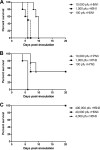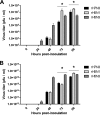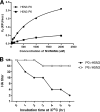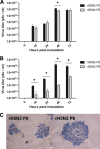Hemagglutinin-Neuraminidase Balance Influences the Virulence Phenotype of a Recombinant H5N3 Influenza A Virus Possessing a Polybasic HA0 Cleavage Site
- PMID: 26246579
- PMCID: PMC4621126
- DOI: 10.1128/JVI.01238-15
Hemagglutinin-Neuraminidase Balance Influences the Virulence Phenotype of a Recombinant H5N3 Influenza A Virus Possessing a Polybasic HA0 Cleavage Site
Abstract
Although a polybasic HA0 cleavage site is considered the dominant virulence determinant for highly pathogenic avian influenza (HPAI) H5 and H7 viruses, naturally occurring virus isolates possessing a polybasic HA0 cleavage site have been identified that are low pathogenic in chickens. In this study, we generated a reassortant H5N3 virus that possessed the hemagglutinin (HA) gene from H5N1 HPAI A/swan/Germany/R65/2006 and the remaining gene segments from low pathogenic A/chicken/British Columbia/CN0006/2004 (H7N3). Despite possessing the HA0 cleavage site GERRRKKR/GLF, this rH5N3 virus exhibited a low pathogenic phenotype in chickens. Although rH5N3-inoculated birds replicated and shed virus and seroconverted, transmission to naive contacts did not occur. To determine whether this virus could evolve into a HPAI form, it underwent six serial passages in chickens. A progressive increase in virulence was observed with the virus from passage number six being highly transmissible. Whole-genome sequencing demonstrated the fixation of 12 nonsynonymous mutations involving all eight gene segments during passaging. One of these involved the catalytic site of the neuraminidase (NA; R293K) and is associated with decreased neuraminidase activity and resistance to oseltamivir. Although introducing the R293K mutation into the original low-pathogenicity rH5N3 increased its virulence, transmission to naive contact birds was inefficient, suggesting that one or more of the remaining changes that had accumulated in the passage number six virus also play an important role in transmissibility. Our findings show that the functional linkage and balance between HA and NA proteins contributes to expression of the HPAI phenotype.
Importance: To date, the contribution that hemagglutinin-neuraminidase balance can have on the expression of a highly pathogenic avian influenza virus phenotype has not been thoroughly examined. Reassortment, which can result in new hemagglutinin-neuraminidase combinations, may have unpredictable effects on virulence and transmission characteristics of a virus. Our data show the importance of the neuraminidase in complementing a polybasic HA0 cleavage site. Furthermore, it demonstrates that adaptive changes selected for during the course of virus evolution can result in unexpected traits such as antiviral drug resistance.
Copyright © 2015, American Society for Microbiology. All Rights Reserved.
Figures








Similar articles
-
Insertion of Basic Amino Acids in the Hemagglutinin Cleavage Site of H4N2 Avian Influenza Virus (AIV)-Reduced Virus Fitness in Chickens is Restored by Reassortment with Highly Pathogenic H5N1 AIV.Int J Mol Sci. 2020 Mar 28;21(7):2353. doi: 10.3390/ijms21072353. Int J Mol Sci. 2020. PMID: 32231159 Free PMC article.
-
Amino acid substitution at position 44 of matrix protein 2 of an avirulent H5 avian influenza virus is crucial for acquiring the highly pathogenic phenotype in chickens.Arch Virol. 2015 Aug;160(8):2063-70. doi: 10.1007/s00705-015-2470-7. Epub 2015 Jun 17. Arch Virol. 2015. PMID: 26081872
-
Characterization of pseudoparticles paired with hemagglutinin and neuraminidase from highly pathogenic H5N1 influenza and avian influenza A (H7N9) viruses.Virus Res. 2018 Jul 15;253:20-27. doi: 10.1016/j.virusres.2018.05.024. Epub 2018 May 31. Virus Res. 2018. PMID: 29859234
-
The Effects of Genetic Variation on H7N9 Avian Influenza Virus Pathogenicity.Viruses. 2020 Oct 28;12(11):1220. doi: 10.3390/v12111220. Viruses. 2020. PMID: 33126529 Free PMC article. Review.
-
Realities and enigmas of human viral influenza: pathogenesis, epidemiology and control.Vaccine. 2002 Aug 19;20(25-26):3068-87. doi: 10.1016/s0264-410x(02)00254-2. Vaccine. 2002. PMID: 12163258 Review.
Cited by
-
A review of H5Nx avian influenza viruses.Ther Adv Vaccines Immunother. 2019 Feb 22;7:2515135518821625. doi: 10.1177/2515135518821625. eCollection 2019. Ther Adv Vaccines Immunother. 2019. PMID: 30834359 Free PMC article. Review.
-
Genetic Characterization of a Novel North American-Origin Avian Influenza A (H6N5) Virus Isolated from Bean Goose of South Korea in 2018.Viruses. 2020 Jul 17;12(7):774. doi: 10.3390/v12070774. Viruses. 2020. PMID: 32709116 Free PMC article.
-
Synergistic Effect between 3'-Terminal Noncoding and Adjacent Coding Regions of the Influenza A Virus Hemagglutinin Segment on Template Preference.J Virol. 2021 Aug 25;95(18):e0087821. doi: 10.1128/JVI.00878-21. Epub 2021 Aug 25. J Virol. 2021. PMID: 34190596 Free PMC article.
-
Avian Influenza A(H9N2) Virus in Poultry Worker, Pakistan, 2015.Emerg Infect Dis. 2019 Jan;25(1):136-139. doi: 10.3201/eid2501.180618. Emerg Infect Dis. 2019. PMID: 30561309 Free PMC article.
-
Variable impact of the hemagglutinin polybasic cleavage site on virulence and pathogenesis of avian influenza H7N7 virus in chickens, turkeys and ducks.Sci Rep. 2019 Aug 9;9(1):11556. doi: 10.1038/s41598-019-47938-3. Sci Rep. 2019. PMID: 31399610 Free PMC article.
References
-
- Tong S, Li Y, Rivailler P, Conrardy C, Castillo DA, Chen LM, Recuenco S, Ellison JA, Davis CT, York IA, Turmelle AS, Moran D, Rogers S, Shi M, Tao Y, Weil MR, Tang K, Rowe LA, Sammons S, Xu X, Frace M, Lindblade KA, Cox NJ, Anderson LJ, Rupprecht CE, Donis RO. 2012. A distinct lineage of influenza A virus from bats. Proc Natl Acad Sci U S A 109:4269–4274. doi:10.1073/pnas.1116200109. - DOI - PMC - PubMed
-
- Tong S, Zhu X, Li Y, Shi M, Zhang J, Bourgeois M, Yang H, Chen X, Recuenco S, Gomez J, Chen LM, Johnson A, Tao Y, Dreyfus C, Yu W, McBride R, Carney PJ, Gilbert AT, Chang J, Guo Z, Davis CT, Paulson JC, Stevens J, Rupprecht CE, Holmes EC, Wilson IA, Donis RO. 2013. New world bats harbor diverse influenza A viruses. PLoS Pathog 9:e1003657. doi:10.1371/journal.ppat.1003657. - DOI - PMC - PubMed
-
- Li KS, Guan Y, Wang J, Smith GJ, Xu KM, Duan L, Rahardjo AP, Puthavathana P, Buranthal C, Nguyen TD, Estoepangestie ATS, Chaisingh A, Auewarakul P, HTlong Hanh NTH, Webby RJ, Poon LLM, Chen H, Shortridge KF, Yuen KY, Webster RG, Peris JSM. 2004. Genesis of a highly pathogenic and potentially pandemic H5n1 influenza virus in eastern Asia. Nature 430:209–213. doi:10.1038/nature02746. - DOI - PubMed
Publication types
MeSH terms
Substances
LinkOut - more resources
Full Text Sources
Medical

